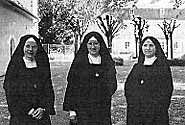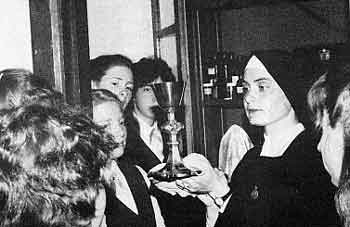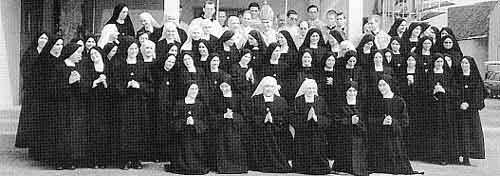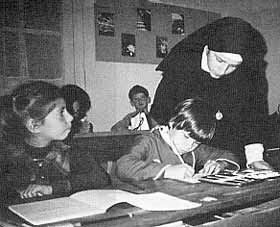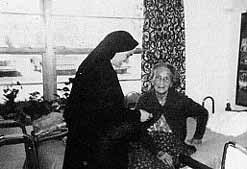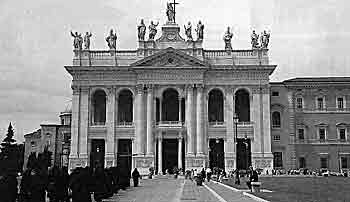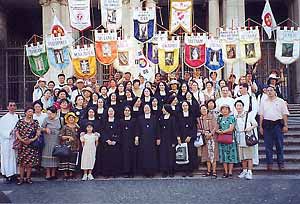

![]()
![]()
|
Religious
Communities for Women THE SISTERS OF SAINT PIUS X Another Flower planted by Divine Providence Very often, when a young girl thinks of a religious vocation, her gaze is drawn automatically towards those religious Orders which have come down to us through the centuries and whose founders have been canonized by Holy Church. These saints, such as St. Teresa of Avila, St. John of the Cross, St. Dominic, St. Benedict, St. Francis of Assisi, have left to their spiritual sons and daughters a specific doctrine of sanctification which in its turn has produced many canonized saints. Hardly a glance perhaps, would be given to a new congregation such as the Sisters of the Society St. Pius X, whose apostolate is apparently an unknown, humble and insignificant one.
(Left)
Rev. Mother Mary Jude, Why is there such a great variety of religious Orders in the Church? It is because the Church is an immense garden where every flower has its own place and necessity. A violet could never be a rose and a rose could never be a daffodil. Why not? Because each plant is different. This is what makes God's garden so beautiful. What is it that differentiates one religious institute from another? It is its spirit. It is that driving force which animates its members and has been the influencing factor in determining how each congregation will live its religious life and keep the vows - as manifested in the Constitution or Rule of that Institute. It is the spirit of the founder that permeates the lives of its members like a fragrant perfume. In order to understand the spirit of the religious congregation, however, we must first go back to its origin. If we trace back to the origin of each of the great monastic Orders, we can see that throughout the centuries, God has always raised up within His Church souls who had a mission to bring to light some moral or doctrinal points of the Catholic Faith which had been neglected or questioned by her enemies in order to weaken the Faith or in a bid to destroy the Church entirely.
September
22, 1974: Founders Archbishop Marcel LefebvreThe Church experiencing, especially after the Second Vatican Council, a crisis such as she had never known in her history, God raised up 'a Prelate who stood in absolute opposition to this wave of apostasy and impiety by preserving the priesthood, by forming good priests'. (cf message of Our Lady at Quito in the 16th century) This Prelate, more than likely, is His Excellency Archbishop Marcel Lefebvre, Founder of the Sisters of the Society of Saint Pius X as well as of the priests of the Society of Saint Pius X. Seminarian in Rome, diocesan priest, religious, missionary in Gabon, rector of seminaries, Archbishop of Dakar, Apostolic Delegate, Superior General of the Holy Ghost Fathers... 'Few persons in the Church were able to acquire the experience and information in the measure Archbishop Lefebvre was able to do it, not by his own will, but by the will of Providence'. By all this rich experience, God prepared him to found an international priestly Society and religious Congregation in the Church and for the Church. Following Divine Providence, little by little things fell into place and the Society St. Pius X was officially founded on November 1, 1970. Less than four years later the branch of the Sisters was also formed. Since the foundation, and until his death in 1991, the Sisters had many contacts with the Archbishop who loved to visit us at the Mother House where he instructed us in the spiritual life and taught us to love the Church. The example of his virtues with humility as their base and charity at the summit, all with such candid simplicity, firm faith and calm fortitude, radiated his love and defence for Christ and incited us to imitate our dear Saviour by living fully our consecration.
Catechism and training of young girls to the liturgical life Mother Mary GabrielMother Mary Gabriel, the fourth child of the Lefebvre family, was a year and a half younger than the Archbishop. After entering the missionary Order of the Holy Ghost Sisters, Mother Mary Gabriel was professed on March 20, 1930. Fifty-six years later, barely six months before her death, she still evoked fond memories of the missionary life she so loved and would have liked to take up again. She had travelled into the most diverse countries: Martinique and Guadeloupe in the West Indies, Cameroon, Senegal and the Central African Republic, where she baptised "in extremis" more than a hundred little black children who now make up her crown in Heaven. With untiring devotion to duty, she manifested her love for God and neighbour, especially in her role as a nurse, when she took care of her sick ones, her lepers at Bangui. Having a deep-seated humility, she never talked about the great responsibilities she had in her congregation. She was Assistant-General and Visitor. She devoted herself entirely to everything she did; thus she lived her total gift to God, not made up of beautiful words, but of simplicity in activity as in prayer. When Archbishop Lefebvre asked her if she would come and help in founding the Congregation of the Sisters of the Society of St. Pius X, she hesitated but it was with the same zeal, the same liveliness that she responded and made once again the complete gift of herself. She was in the image of Our Lady, the co-foundress of this great Work willed by God for the salvation of souls and for His greater glory. Mother Mary Gabriel was for all of us a model of religious life. She had a deep sense of the virtue of charity, which made her excel in courtesy and good manners. She always had time to comfort a soul, to listen to parents or anyone who needed to confide their troubles and worries. In all circumstances, she was guided by her love of God, her primary aim being the extension of the love of God in souls. And in her novices, how she inculcated in them the love of humble, daily tasks, the love of simplicity, the love of duty! She could never understand how one could give oneself to God with measure - for her it was all or nothing. How often even in her advanced years, did she show us how to work in the garden, to use limited space to the full, to produce, with very little, enough for all. She was always resourceful, full of strength, and she possessed an undaunted enthusiasm. From the sewing room to the garden, from the chicken coop to handling a screwdriver, hammer or saw, from the organ to the sick room, Mother was just as proficient. Deep too, was Mother's love of poverty. As a missionary, she taught us the virtue of poverty. The necessary would do, anything else was considered superfluous. She taught us to do without and not to complain. Even up until her death her bedside table was a trunk! Suffering disappointments, sickness and different trials… she felt them keenly, yet she never complained, was never bitter. Animated with a profound spirit of Faith, she had indeed given everything to God. Her work was a continual prayer, for the duty of state had an important place in her religious life. It was the expression of the Divine Will, and she could not pray better than doing God's very Will. Her occupations were illuminated by her deep piety which she had received from her parents, and which she made bear fruit from day to day. She used to say: "Once you have been clothed in the religious habit, your time no longer belongs to you. It belongs to the Church." She was very joyful. Her good disposition, her care for others, her tender delicate nature came from a living faith. She loved to say in her lectures on the religious life, "Joy and holiness - it is all one". Such was Mother Mary Gabriel, the sister of His Grace, Archbishop Lefebvre, and co-foundress of our Congregation.
Quasimodo Sunday 1986: The Sisters with their Founder after the taking of the Habit Spirit of the Sisters of the SocietyTo understand the spirit of the Sisters of the Society of St. Pius X, we must go back to Calvary on the very day that Our Lord was crucified. Jesus was suffering atrociously. Every once in a while He opened His eyes and looking down, He saw His beloved Mother, several holy women and St. John, His faithful priest, standing at the foot of the Cross. Seeing that His end was coming, Jesus gave Our Lady one last look and said, "Woman, behold thy son", and to St. John, "Son, behold thy Mother". In this Our Lord entrusted to His Mother the treasure most dear to His Sacred Heart: the Catholic Priesthood. Our Lady received from Our Lord a new mission. By her humble and hidden life, she was to do for St. John and the other Apostles, the first priests, that which she had always done for her Divine Son. Her prayers, yes, would help them; but she was also to relieve them in their material cares and in the apostolate. She was to serve Christ in His priests. The Sisters of the Society of St. Pius X find their place at the foot of the Cross. Their spirituality is entirely centred on the Holy Sacrifice of the Mass and the soul of the Virgin Mary under her beautiful title of Our Lady of Compassion.
Many centuries have passed since that first Good Friday when Our Lord underwent His Agony and Passion and at last consummated His sacrifice for our sins. Today, Our Lord is suffering His Passion and Crucifixion again in His Mystical Body. And, since it is the Priesthood and the Holy Sacrifice of the Mass that are being attacked, He has planted another "flower" in the garden of the Church and it is called the Sisters of the Society of St. Pius X. True, this plant is still young, but after 25 years it has taken solid root, and with God's grace it is still flourishing to His greater glory. The religious of the Society prolongs, in time, the Compassion of Mary and her Immaculate Heart, in associating herself more particularly with the torments that Jesus endured for the souls of today - in offering herself with the Divine Victim and with the Virgin Mary, in praying for priests, in serving Our Lord in His priests.
Teachers in Primary School A Congregation of "Mixed Life" The Congregation of the Sisters of the Society of St. Pius X is what is called a Congregation of "mixed life", that is, a blend of the active and contemplative lives. While the Sisters are not a totally active Order like teaching Orders, neither are they totally cloistered like the Carmelites. Our Lord Himself lived a mixed life, preaching and working miracles, then retiring to places of solitude where He could spend many hours in prayer. At the end of six months of postulancy, the two-year noviciate begins with the taking of the habit. It is only after this second stage of probation that the Sisters make the profession to live according to the three vows of poverty, chastity and obedience, which they promise to observe. These two and a half years of formation are not filled by prayer alone. They attend classes on various subjects such as the Church, its History, Sacred Scripture, as well as spiritual conferences. They also have their share of material tasks, such as gardening, the upkeep of the property and of the few animals and fowl kept to provide some food. After their profession, the Sisters are sent to various houses of the Society, where they will help and complete the priestly apostolate by various works: catechism, visits to the sick, sacristy, primary schools, etc. The knowledge acquired during the Noviciate might enable them to do more: making of Altar breads, making and repairing of priestly vestments, playing the organ, singing, gardening, as well as daily duties such as cooking, cleaning, washing, etc. Every day, the Sisters have an hour of adoration before the Blessed Sacrament, in order to pray for diverse intentions: for the Pope, for Bishops, priests, consecrated souls, and in particular, to make reparation for the outrages committed against Our Lord in the Blessed Sacrament. It is in fact the contemplation and imitation of Christ on the Cross that makes the true Christian and gives all its value and grandeur to the religious life. Every true Christian, through Baptism, is a missionary, but by their religious consecration the Sisters are totally dedicated to the Church, working to extend the reign of Christ the King through their own sanctification and through their apostolate. If prayer and spiritual growth are the most important aspects in the life of a baptised soul, they are even more so for a Religious, and especially for a Sister of the Society who is an auxiliary of priests far more by her life of union with Our Lord than by exterior activities. Her whole life is centred on the Sacrifice of the Mass, source of all graces. Thus, her interior life - and by extension, her apostolic life - flow from the very Sacrifice of Our Lord Jesus Christ and her union with Our Lady of Compassion.
Work with the sick and the elderly History and expansion of the Congregation November 1, 1970 was the date of the Canonical foundation of the Priestly Society of St. Pius X in Fribourg, Switzerland. His Grace, Archbishop Marcel Lefebvre, an important figure in the mission field of the Church and an eminent defender of the Faith, both during and after the Second Vatican Council, established a seminary to train young men for the priesthood of Our Lord Jesus Christ, young priests to continue the true Sacrifice of the Mass. Who will pray and offer sacrifices for these priests? Who will assume the more humble tasks, allowing the priests to give themselves more freely to their priestly duties? Who will take care of the chapels, the altar linens, and the vestments? Who will teach catechism to the children, giving them the truths of the Faith and a love for it that will lead them to Heaven? Who will visit the aged and the sick? This is the way His Grace explained it: "It is quite a normal thing that in founding a community for men, I sought the possibility of being helped in the apostolate by religious, in order to facilitate the work of the priests and to support them by prayer.
In September 1974, Monseigneur Lefebvre gave the holy habit to the first Sister of the Society St. Pius X. The Sisters' noviciate was near the Eternal City of Rome for three years, before it was transferred in the autumn of 1977 to Saint-Michel-en-Brenne, a tiny village in the centre of France. With the appearance of more postulants, our little family grew, and so began the foundation of houses in other places:
Jubilee
2000 pilgrimage to Rome of the Sisters. In November 1999, after 25 years of existence, the Congregation is comprised of 108 professed Sisters and 15 novices and postulants of 17 different nationalities, thus showing its truly international character, just like the Priestly Society of St. Pius X. The Sisters are dispersed in 19 houses of which 4 noviciates, 7 schools, 8 priories, a seminary, retreat house, nursing home, mission or Mother House, where they pray and work, cooperating in the mission entrusted by Our Divine Lord to His Apostles: "Going therefore, teach ye all nations... Behold I am with you all days..." (Mt. 28:19-20)
SSPX
Sisters with the Asian Pilgrims
Tel: 00
54 2322 47 01 78
|
|||||||||||||||||||||||||||||||||||||||||||||||||||||
